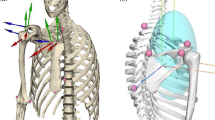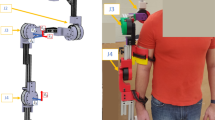Abstract
The human muscle-skeletal system has a large number of redundant muscles, implying that the same motion may be obtained by different combination of muscle forces. As a consequence, the modeling of the kinematics of biomechanical models used for human motion task simulations has important implication on the distribution of the muscle forces and joint reaction forces. This work compares the performance and applicability of three biomechanical models, with different levels of complexity, in face of specific kinematic modeling assumptions for the anatomical joints and muscle geometry. The muscle contraction dynamics is simulated by the Hill-type muscle model, being the activation of each muscle a unknown in the redundant force sharing problem. An optimization technique is applied to minimize of an objective function related with muscle metabolic energy consumption. The input for the model analysis comprises the data for an abduction motion, kinematically consistent with the biomechanical models developed, acquired using video imaging at the Laboratory of Biomechanics of Lisbon.
Access this chapter
Tax calculation will be finalised at checkout
Purchases are for personal use only
Similar content being viewed by others
References
De Groot, J.H.: The shoulder: a kinematic and dynamic analysis of motion and loading. Ph.D. thesis, Delft University of Technology (1998)
Garner, B.A., Pandy, M.G.: The obstacle-set method for representing muscle paths in musculoskeletal models. Comput. Methods Biomech. Biomed. Eng. 3(1), 1–30 (2000)
Garner, B.A., Pandy, M.G.: Musculoskeletal model of the upper limb based on the visible human male dataset. Comput. Methods Biomech. Biomed. Eng. 4(2), 93–126 (2001)
Van der Helm, F.C.T.: A standardized protocol for motion recordings of the shoulder. In: Proceedings of the First Conference of the ISG, pp. 7–12. Delft, The Netherlands (1997)
Van der Helm, F.C.T., Veeger, H.E.J., Pronk, G.M., Van der Woude, L.H.V., Rozendal, R.H.: Geometry parameters for musculoskeletal modelling of the shoulder system. J. Biomech. 25(2), 129–144 (1992)
Hong, Y., Bartlett, R.: Handbook of Biomechanics and Human Movement. Routledge, New York (2008)
Nikravesh, P.: Computer-Aided Analysis of Mechanical Systems. Prentice-Hall, Englewood Cliffs, New Jersey (1988)
Praagman, M., Chadwick, E.K., Van der Helm, F.C.T., Veeger, H.E.: The relationship between two different mechanical cost functions and muscle oxygen consumption. J. Biomech. 39(4), 758–765 (2006)
Quental, C., Folgado, J., Ambrósio, J., Monteiro, J.: A multibody biomechanical model of the upper limb including the shoulder girdle. Multibody Syst. Dyn. (2012). DOI 10.1007/s11044-011-9297-0
Silva, M., Ambrósio, J.: Kinematic data consistency in the inverse dynamic analysis of biomechanical systems. Multibody Syst. Dyn. 8(2), 219–239 (2002)
Silva, M., Ambrósio, J.: Solution of redundant muscle forces in human locomotion with multibody dynamics and optimization tools. Mech. Based Des. Struct. Mach. 31(3), 381–411 (2003)
Silva, M., Ambrósio, J., Pereira, M.: Biomechanical model with penalized joint rotation for impact simulation. Multibody Syst. Dyn. 1(1), 65–84 (1997)
Acknowledgements
This work was supported by the Foundation for Science and Technology through the project PTDC/SAU-BEB/103408/2008 and a PhD scholarship – SFRH/BD/46311/2008. The authors are grateful to Daniel Simões Lopes, Paulo Luzio de Melo and Nelson Ribeiro for their assistance at the Laboratory of Biomechanics of Lisbon.
Author information
Authors and Affiliations
Corresponding author
Editor information
Editors and Affiliations
Rights and permissions
Copyright information
© 2012 Springer Science+Business Media Dordrecht
About this paper
Cite this paper
Ambrósio, J., Quental, C., Folgado, J., Monteiro, J. (2012). Dynamics of the Upper Limb with a Detailed Model for the Shoulder. In: Lenarcic, J., Husty, M. (eds) Latest Advances in Robot Kinematics. Springer, Dordrecht. https://doi.org/10.1007/978-94-007-4620-6_52
Download citation
DOI: https://doi.org/10.1007/978-94-007-4620-6_52
Publisher Name: Springer, Dordrecht
Print ISBN: 978-94-007-4619-0
Online ISBN: 978-94-007-4620-6
eBook Packages: EngineeringEngineering (R0)




